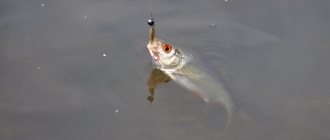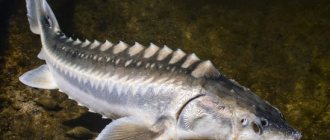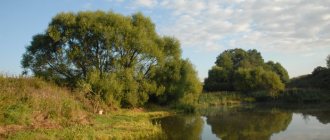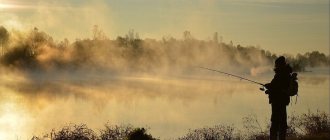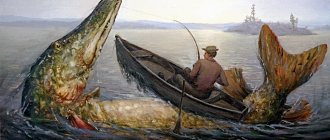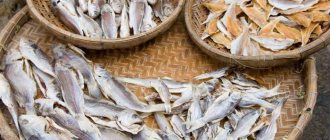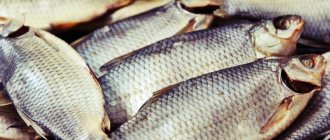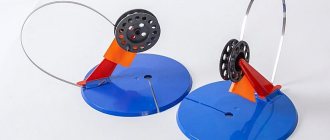The largest freshwater lake in Europe, Lake Ladoga has long been known for the richness of its waters. Largely due to the fact that forty rivers flow into Ladoga, and only one Neva flows out, the lake’s water resources are constantly replenished, and different types of fish enter the lake with river waters.
The beautiful landscape of Karelia, flat terrain and temperate climate - on Ladoga nature has created all the conditions for fishing. The most popular catch on Lake Ladoga is pike perch - this fish is of particular commercial importance here. Whitefish and smelt are also caught in commercial quantities. Slightly less roach, bream, perch, ide, vendace, pike, trout and ruff are caught in Ladoga.
Choosing a fishing spot
In order to decide on the choice of fishing spot on Lake Ladoga, you need to know that the behavior of fish and its distribution in different parts of the lake differ. Such features predetermined the ecological differences between the southern and northern parts of the lake. For example, cold-loving fish species (paliya and others) live in the northern part of the lake. Heat-loving fish species (syr, bluefish) prefer to settle in its southern half.
It should also be taken into account that many species of fish living on Ladoga go to the Taipale, Svir, Syas, and Volkhov rivers to spawn. Therefore, many fishermen study the route of the fish. As a rule, fish move at night in autumn and spring along the same route, which does not change from year to year.
Despite the fact that sturgeon, salmon and trout are not very common on Ladoga, these fish are the top trophy for most fishermen. Such fish also live in the lake, but go to the rivers near the lake to reproduce.
In general, the species diversity of fish on Ladoga is so great that fishermen have a catch at all times of the year if they prepare for fishing on Ladoga responsibly and in advance, and also take into account the seasonality of fish biting, its activity depending on weather conditions, the time and place of spawning .
It is important to remember that certain species of fish living in Lake Ladoga can be caught at strictly defined times, otherwise ignorance of all fishing periods can turn an amateur fisherman into a poacher.
It is important to remember that the weather conditions on Ladoga in the winter and off-season are very harsh; calm can only be observed in the summer. Complete calm sets in on Ladoga for a short time in June; the rest of the time, Ladoga quite often demonstrates its stormy temper. It rains most days of the year in this area, so the fisherman should always have the necessary equipment with him, regardless of the fact that the day before departure the weather was sunny and calm.
Winter fishing on Ladoga - where to fish
Where else can you fish in winter on Lake Ladoga? St. Petersburg fishermen know the following places: Chernoe, Lednevo, Lavrovo, Nizhnyaya Shaldikha, Nazia, Kokkorevo. Near these settlements, as a rule, fish are caught.
From Cherny to Lednevo
The Chernoe-Lednevo section can only be reached by car. The floating bridge connects Ladoga and Chernoye. We go out onto the ice via this bridge. From Lednevo you can get to the Ladoga ice through the Novoladoga Canal. Be careful in the Chernoe-Lednevo section. It's not very far from clean water. With a strong southerly wind, fast ice can be pulled away from the shore. The north wind causes ice ridges.
Perch, roach, bream, ruff and pike are caught using jigs and spoons. If you're lucky - whitefish, ripus and vendace.
From Lavrovo through Nizhnyaya Shaldikha to Nazia
Opposite these settlements, Ladoga is the shallowest. We go out onto the ice through the Novoladozhsky Canal.
Perch and roach are caught well with a jig. Pike bite well on the balance beam not far from the shore, at the edge of the reeds. The girders are also placed here. The Ladoga whitefish may be interested in the spinner.
Kokkorevo – Platform 44 km
You can get here either by car or by train from the Finland Station.
Mostly roach, perch and ruff bite here. As a nozzle - bloodworms, maggots, flavored dough. We go for perch with a spoon. You have to fish far from the shore, where there is a drop in depth or on banks.
Fishing tactics on Ladoga
They fish on Ladoga using a wide variety of fishing methods and techniques, both well-known and those developed by themselves. The most common fishing methods on Ladoga are:
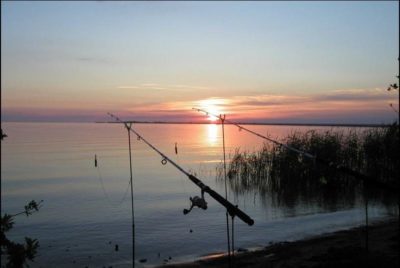
spinning fishing, including trolling and trolling;- fishing with all types of float rods;
- fishing with a boat (popularly this fishing method is also called Katyusha).
Modern fishermen, who know the harsh, unstable climatic conditions on Ladoga, prefer to be equipped with the highest class - they buy modern trolling equipment, echo sounders and even rent boats. It is quite clear that such serious preparation also presupposes a serious catch, for example, pike perch or pike, and perhaps Ladoga salmon.
In order for the fishing results to truly meet the fisherman’s expectations, the bottom topography is first examined using an echo sounder and an audit of the fish living there is made. After this, using a wobbler or other bait, they fish a certain surface of the lake. Depending on the chosen fishing area, the depth of fishing also depends.
Roshchinskie lakes.
(Len. region)
This is the conventional name given to a group of lakes located on the western edge of the Karelian Upland, in the interfluve of Volochaevka and Sestra among the hills with caps of coniferous forest. The lakes owe their origin to the glacier. Some of them formed in the depressions he plowed out, others in the basins left where the buried dead ice melted. Their shape is round or slightly elongated, the outlines of the banks are smooth. The lakes attract with clean and transparent water, picturesque landscapes, and good places for swimming.
On the left bank of the Volochaevka River lies Lake Chernyavskoye
, connected to it by a short stream. The area of the lake is 0.88 square kilometers, the greatest depth is 6 meters. The lake is surrounded by hills. The shores are mostly dry, only on the northern and western slopes there are small key swamps. The coastal shallows are composed of coarse sand.
The lake is fed by streams with cold water - even in summer on hot days their temperature does not exceed 10 degrees.
On the northern shore is the village of Chernyavskoye. Before the revolution, the Ahi-yarvi estate was located here, which belonged to the outstanding veterinarian M.A. Ignatiev. During the years of preparation for the revolution, in which his son Alexander, later a famous figure in the Bolshevik Party, took an active part, Ahi-yarvi became a storage place for illegal literature and weapons. From the former estate, only the foundation of the house and a few old linden trees have survived.
Not far from Lake Chernyavskoye, in the vicinity of the village of Olshanik, there are several lakes. The largest of them are Olshanskoe
and
Podgornoye
. Olshanskoye lies at the bottom of a depression plowed by a glacier. It is surrounded on all sides by sphagnum swamps. There is little aquatic vegetation.
Lake Podgornoye is no different in size from its neighbor. The depth in it does not exceed 1.5 meters. The lake is half overgrown with pondweed, bramble, and egg capsule. The bottom is muddy.
Marchenkovskoye is well known among tourists.
, with clear bluish water. Its length is 400 meters, its greatest width is 200 meters, its depth is up to 10 meters, with a steep underwater slope. There is a pine forest around the lake on the high banks. The beaches are sandy.
Great depth with a small surface area, rounded shape, hilly shores, steep underwater slopes - everything indicates that the reservoir arose on the site of a buried “splinter” of a glacier. This is a typical kame lake.
Many good places for swimming and relaxation can be found on the picturesque shores of lakes located a few kilometers from the village of Roshchino. Tourist routes have been running along them for a long time. Malaya Ladoga lakes
,
Excavation
and
Filled
. Their total length does not exceed 900 meters. The banks are overgrown with coniferous and mixed forests, only near Zalivnoye in the north and southeast there are wetlands.
Bolshoye Simaginskoe is especially popular.
Beauty
for the picturesqueness of its shores, the green expanse of water and golden beaches . The lake covers an area of 2.7 square kilometers. It stretches from northwest to southeast for 2.8 kilometers, the width does not exceed 1.2 kilometers, and the greatest depth is 19 meters.
The eastern shore is high and steep, with rows of slender pines lined above its sandy cliffs. To the south and southwest, the shore goes down, spruce trees are mixed with pines, and in some places thin birch trees approach the water itself.
The western bank is the lowest, with meadows and clearings. This is where the Nizhnyaya River begins, flowing into the Gulf of Finland. Protected from the winds by high banks, the lake slowly mixes. In the summer, on some days, the upper layers of water already have time to heat up to 23 degrees, while at a depth of 8 - 10 meters the water temperature can be only 13 - 15 degrees.
There are a lot of fish in the lake. It is usually caught from a boat, away from the noisy shore. The beauty has been serving as a vacation spot for Leningrad children for many years; many tourists come here from different parts of the country. On the northern shore, on a low terrace, a tent tourist camp is set up every summer. There is a boat station nearby. Water skiers also chose the lake for their training.
The surrounding area is of great natural value, where beautiful pine and spruce forests have been preserved in their original form.
Near the lake is the village of Ilyichevo (formerly Yalkala). From here a forest path leads to the house-museum of V.I. Lenin. This is a one-story wooden building with an extension, standing on the edge of a large clearing. In the house that belonged to the former St. Petersburg worker P.G. Parviainen, V.I. Lenin lived and worked for several days in August 1917, hiding from persecution by the bourgeois Provisional Government. (In 1970, a protective pavilion was erected above the house.)
In Yalkala, V.I. Lenin wrote several articles and continued to work on his brilliant work “State and Revolution”. Vladimir Ilyich more than once spent short hours of rest on the shore of Lake Kauk-yarvi (as Lake Beauty was previously called) or walked through the forest with the owner’s children, who were picking mushrooms and berries.
Another lake is associated with V.I. Lenin’s stay on the Karelian Isthmus - Gladyshevskoye
. It is located near the village of Gorkovskoye (formerly Neyvola and Kiryavola), where at the end of June - beginning of July 1917, Vladimir Ilyich rested at the dacha of the famous figure of the Bolshevik Party V.D. Bonch-Bruevich.
Lake Gladyshevskoe lies in a deep basin, surrounded on all sides by hills. Its area is 4.8 square kilometers. The greatest depth, according to some sources, is 14.5 meters, according to others - up to 24 meters. The banks are almost everywhere high, covered with dense coniferous forest. Only in the west are they low and swampy. On the southern coast, the coniferous forest in places gives way to meadows and clearings framed by alder thickets. The northern coast is especially beautiful. A dark forest descends along it in several tiers, leaving only a narrow strip of sand near the water.
The small river Velikaya flows into the lake, connecting it with Lake Nakhimovsky, and the rapids Gladyshevka, a tributary of the Chernaya River, flows out. In many places on the shore and at the bottom of the lake there are cold springs.
The high shore, protecting the lake from strong northern winds, retards the mixing of its waters, which is why in the upper layers they warm up well, and in the depths they remain cold for a long time during the summer.
Sometimes the surface layer of water is driven away from the shore by the wind, and deep waters enter in its place, causing cold currents. Local old-timers have long noticed this phenomenon. Few of them dare to swim far from the shore. And here is what V.D. Bonch-Bruevich writes, recalling the days spent by V.I. Lenin on the shores of Lake Gladyshsvskoe. He came here at the insistence of members of the Party Central Committee to improve his health and immediately became interested in swimming in the lake.
“I used to be terrified to look at him,” says Bonch-Bruevich, “he would float away far, far into a huge lake, the line of the other shore of which was hidden in the foggy distance, and there he would lie down somewhere and sway on the waves... But I knew and warned him that that there are cold currents in the lake, that it is extremely deep, that there is a whirlpool and pools in it, that, finally, many people drown in it and that for all this you need to be careful and not swim far.
Where there!
“They’re drowning, you say?” Vladimir Ilyich would ask again, carefully undressing...
- Yes, they are drowning, just recently...
- Well, we won’t drown... Cold currents, you say, are unpleasant... Well, that’s okay, we’ll bask in the sun... - Deep?
- What’s deeper!..
- We must try to reach the bottom...
I realized that it was better not to tell him any of this, since he, like a real avid athlete, more and more every time these stories begin to become inflamed, to become enthusiastic ... "
At different times, M.E. Saltykov-Shchedrin, who described these places in “Little Things in Life,” the remarkable figure of Russian medicine S.P. Botkin, the artist I.N. Kramskoy, the poet Demyan Bedny lived in the villages scattered on the shores of Lake Gladyshevskoye. .
In 1913 - 1917, Alexey Maksimovich Gorky came here on vacation. In Mustamaki, his first meeting took place with V.V. Mayakovsky, who brought his poems “Cloud in Pants” and “Spine Flute” to the writer’s court.
Features of Lake Ladoga
Few people know that the amazing Lake Ladoga - the largest in Western Europe - gives “life” to just one river, the Neva. But many sources flow into it. It is not for nothing that most local residents and guests of the region combine their vacation there with fishing on Ladoga in winter and summer. Here is where:
- Take up bottom fishing.
- Go fishing from a boat.
- Hunt underwater.
- Throw gear from the shore.
- Fish from the ice.
The bottom topography of Lake Ladoga is very heterogeneous. In the north, where the depth reaches 220 meters, it is cut by sharp changes in elevation. But closer to the south, the “terrain” levels out, and the distance from the surface to the bottom ranges from 15 to 70 meters. The depth reaches its maximum at a point near the Valaam archipelago - 233 meters.
Map of the depths of Lake Ladoga. It is used to plan fishing spots
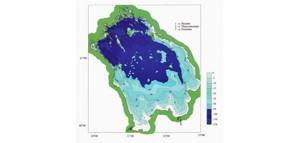
In the waters of the lake there are about 500 islands of various sizes. And at each of them, a holiday on Ladoga can be crowned with successful fishing. The cold in these places, as throughout Karelia, comes early: already in the middle (sometimes at the end) of October the reservoir freezes. Winter fishing on Ladoga ends in April - the ice begins to lose its position, first in the center, and then closer to the shores. But it should be noted that the central part of Ladoga freezes only when the thermometers are very negative.
Ladoga freezes to a depth of 70-90 cm in the most severe frosts
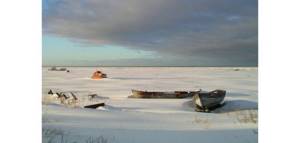
As for the weather, fishermen should be aware that complete calm can give way to a storm in the blink of an eye. To avoid falling into the “trap”, check the hydrometeorological center reports before going to the lake.
Ladoga perch: spoon or balancer?
13.03.2018

In this article I would like to share my thoughts on the topic: what determines the choice of bait when catching perch on Lake Ladoga in winter. Personally, I don’t consider myself either a fan of the balancer or an apologist for the spinner - for me the main thing is that it bites, and what’s tied at the other end of the fishing line is not important. But many lure fishermen are ready to defend their opinion with foam at the mouth and try to impose it on others. In the hierarchy of winter perch hunters, the highest caste is usually considered to be those who fish with a spinner with a soldered-in double, with a “soldered-in”. From their point of view, even those who use vertical spinners with a hanging tee no longer fall under the definition of real spinners. What can we say about balancer lovers? In the eyes of fans of “soldering”, these fishermen are not far removed from the “jig shakers”, or, as they are sometimes contemptuously called, “bump shakers”.
I don’t want to impose my opinion on anyone, but my conclusions are based on almost 20 years of experience in catching perch using the winter lure method and are based on observations of the behavioral characteristics of the Ladoga perch.

As you know, Ladoga perch is a schooling fish. In large schools or small flocks, it moves across the expanses of Ladoga in search of prey, which also includes schooling vendace and smelt. If an angler finds himself in the center of a perch hunt, he is guaranteed a catch. In such a situation, soldering would be the best choice. It is much easier to remove the caught fish from the hook, the fishing process is accelerated, and the bites on the “soldering” are the most impressive. But it's not that simple. Even a hungry perch almost never bites throughout the day. There are so-called “exits” - periods of active biting. Nobody knows what causes them. There may be one “exit” per day, or maybe several. But in the intervals between “outings” it is quite possible to catch perch, albeit not in “elevator mode”, but very successfully. Under such conditions, soldering is unlikely to work effectively. It is better to use a spoon with a hanging tee or a balancer. But no one will advise you on what to choose. If there are other spinners fishing around you, you can spy on what kind of bait they are catching fish on, and sometimes it’s enough just to listen to their conversations among themselves.
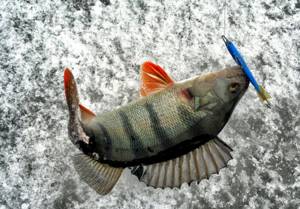
If, during a period of inactive biting, I manage to catch one, or better yet several bass, from a hole, I will never leave this hole without trying other baits. The scheme of my actions is as follows: if there are empty bites on the balancer, you can put a smaller balancer or a dull color. If there are no bites, I set up a lure with a “suspension” and continue fishing. Every angler has his own favorite lures, and this is no coincidence. It was with these spoons or balancers that he managed to catch perch well. This bait should be used first. If this does not help, you can experiment - put the bait to which, in the opinion of the fisherman, a predator might react. There is no need to present the fisherman as a kind of stupid breadwinner, as our media regularly do. A thought process constantly occurs in the head of any spinner, aimed at understanding how the object of his hunt behaves. Winter echo sounders of the “Practician” series can provide serious assistance. On the echo sounder display you can clearly see how the perch rises behind the spoon, “sniffs” it and goes home. This is where you need to use your imagination. True, often no tricks help, and then it is better to look for a more catchy hole.
If anyone doesn’t know, when fishing for perch on Ladoga it is necessary to fish not only the bottom layer, but also different water horizons; very often the fish bite at half-water.

I can’t say why the perch sometimes bites better on a spoon and sometimes on a balancer. Perhaps this is somehow related to the behavior of its prey, i.e. vendace or smelt move either in a horizontal plane or in a vertical one. A balancer, at its core, is a horizontal bait that makes pirouettes in the form of a “figure of eight”, and a winter spinner is a bait that makes quite complex movements in a certain vertical area. In addition, there are situations when the perch is completely indifferent to what kind of bait is suspended at the other end of the fisherman’s fishing rod - the perch equally willingly attacks both balancers and spoons. But balancers have one significant drawback - when fishing for fish, either the front or rear hook often clings to the edge of the hole, which leads to perch escapes that are offensive to the angler.
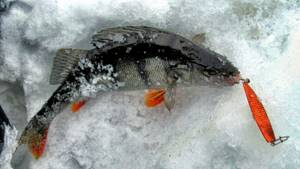
In spring, perch on Ladoga becomes extremely capricious. The time for the “mormyshatniks” is coming. But we noticed that at this time it can still be caught with small balancers, of course, not as successfully as with bloodworms, but still better than with spoons.
I apologize that throughout the entire article I did not name a single spinner model or mention a single balancer. This was not my task. I wanted to draw your attention to the fact that all lures for winter trolling deserve respect, since a thinking angler can find a use for them in almost any situation.
Alexey Beltenev
Bonuses awarded:400
Lures for catching perch
| Balancers from 105 rub. | Verticals from 69 rub. | Jigs from 10 rub. |
